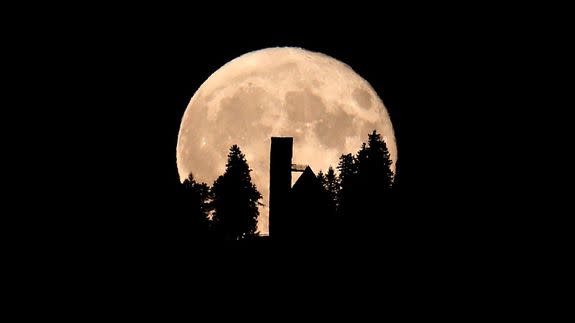You won't see a supermoon like this for decades

On November 14, the most super of supermoons will rise. And no matter where you are in the world, you'll be able to see it (assuming you have good weather).
The moon will be at its full phase as the natural satellite reaches its closest point to Earth in its orbit (called perigee), making it a supermoon on November 14. On that day, the moon should appear about 30 percent brighter and 14 percent larger than when the moon is at its farthest point from our planet (called apogee).
But this supermoon isn't like others before it.
SEE ALSO: 13 Spectacular 'Supermoon' Photos From Mashable Readers
Next week, the moon will reach full phase as it's at its closest point to Earth for the first time in decades and this particular cosmic coincidence won't happen again for a long while.
"This month’s is especially ‘super’ for two reasons: it is the only supermoon this year to be completely full, and it's the closest moon to Earth since 1948, when a gallon of gas cost just 16 cents," NASA said in a statement. "The moon won’t be this super again until 2034."
Supermoons are possible thanks to the fact that the moon's orbit around Earth isn't perfectly circular.
When the moon is at its closest point to our planet, it's actually about 30,000 miles closer than it is at apogee. While that sounds like a vast difference, it doesn't mean that the moon will only look slightly larger and brighter to keen observers.
On average, the moon is somewhere in between its closest and farthest points, meaning that during perigee the lunar body doesn't look all that much different in the night sky.
So many supermoons
Supermoon is a term bandied about quite a lot these days.
Many people labeled October's full moon as a "supermoon" even though it didn't quite fit the original definition.
"Originally a term from modern astrology for a new or full moon that occurs when the moon is within 90 percent of its closest approach to Earth in a given orbit, supermoon now refers more broadly to a full moon that is closer to Earth than average," NASA said in a statement.
October's full moon did fall when the moon was closer to Earth than average, reaching full phase within a day of perigee.
However, November's supermoon is special because the moon will become full within two hours of perigee, NASA said.
If you think of the supermoon in terms of its newer, broad definition, then 2016 is a big year in general.
December's full moon will also be a "supermoon" and blot out the Geminid meteor shower, usually considered one of the year's best annual meteor showers.
"Bright moonlight will reduce the visibility of faint meteors five- to tenfold, transforming the usually fantastic Geminids into an astronomical footnote," NASA said.
